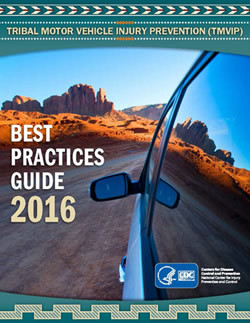Motor vehicle safety resources for tribal communities
By: HIPRC
Date: November 16th, 2016
 American Indians/Alaska Natives (AI/AN) have the highest motor vehicle-related death rates of all racial and ethnic groups, with rates two to three times greater than the rates of other Americans. The following resources can help equip tribal communities to apply motor vehicle injury prevention programs that effectively increase child safety seat use, increase seat belt use, and decrease alcohol-impaired driving.
American Indians/Alaska Natives (AI/AN) have the highest motor vehicle-related death rates of all racial and ethnic groups, with rates two to three times greater than the rates of other Americans. The following resources can help equip tribal communities to apply motor vehicle injury prevention programs that effectively increase child safety seat use, increase seat belt use, and decrease alcohol-impaired driving.
- The Tribal Motor Vehicle Injury Prevention (TMVIP) Best Practices Guide 2016 outlines five important components for TMVIP: commitment, collaboration, data and evaluation, tailored evidence-based strategies, and technical support. Within each component, the guide covers what is needed, lessons learned, case examples, resources, and calls to action for TMVIP programs.
- The Tribal Toolkit was developed in partnership with the Indian Health Service (IHS) to assist tribes in the promotion of evidence-based strategies that take into consideration the unique culture of American Indians/Alaska Natives. The media toolkit includes fact sheets, brochures, posters, and a video titled “A Killer in Indian Country.”
- Evidence-based child passenger safety interventions are both feasible in and transferable to tribal communities. During 2010-2014, five tribal communities funded by CDC implemented evidenced-based strategies from the Guide to Community Preventive Services to increase the use of child safety seats (car seats and booster seats). As a result, child safety seats use increased in all five tribal communities (ranging from 6-40%) and four out of five of the communities exceeded their goals for increased use. Learn more on the Publications page.
This content is courtesy of the CDC Injury Center.

 American Indians/Alaska Natives (AI/AN) have the highest motor vehicle-related death rates of all racial and ethnic groups, with rates two to three times greater than the rates of other Americans. The following resources can help equip tribal communities to apply motor vehicle injury prevention programs that effectively increase child safety seat use, increase seat belt use, and decrease alcohol-impaired driving.
American Indians/Alaska Natives (AI/AN) have the highest motor vehicle-related death rates of all racial and ethnic groups, with rates two to three times greater than the rates of other Americans. The following resources can help equip tribal communities to apply motor vehicle injury prevention programs that effectively increase child safety seat use, increase seat belt use, and decrease alcohol-impaired driving.